Megan Dunn – 30 March, 2012
I realise that photography itself is meant to be the subject here, but the overriding tone I get from Amundsen's art is one of ‘seriousness.' I also disagree that it's all about process and that the content has little consequence. Amundsen's subject matter and colour palette work in tandem to create a vision of urbanity that speaks volumes about taste, class and perspective.
Wellington
Fiona Amundsen, John Lake, Simon Starling, Kohei Yoshiyuki
Camera Work
24 January - 15 April 2012
‘I still need narrative,’ the gallery assistant told me during my visit to Camera Work the latest photography show at the Adam and a part of the NZ International Arts festival.
Camera Work is a banally technical title, a mere statement of fact, it doesn’t promise to tell a story, nor does it come loaded with emotion or a particular polemic. The exhibition highlights the documentary approaches of four artists, Fiona Amundsen, John Lake, Simon Starling and Kohei Yoshiyuki.
The gallery assistant warned me about the potentially offensive content of Yoshiyuki’s photos downstairs telling me the work raised questions about who was watching who.
Exactly. Since I’ve been reviewing art again I’ve begun to consider my own agenda as a watcher. The gallery assistants are every bit as interesting as the art to me - if not more so.
The assistant’s favorite work was Simon Starling’s because it was a ‘kind of elaborate joke.’ The work was a slide show he needed to operate for me. I sat in the darkened auditorium and watched as a small steamboat was taken out to the middle of an innocuous lake, then dismantled with a saw. The artist fed the boat into its own engine, until all that remained was floating Tupperware and other nameless parts bobbing up and down. I laughed.
The assistant then described Starling’s Turner Prize winning work Shedboatshed. He went on to tell me that The Guardian had called Starling the dullest man alive. I could understand why. The slides of this ‘performance’ were taken on an overcast day and the work has retained the dreary, trapped feeling of that afternoon. I couldn’t decide whether I felt happy that the world allowed Starling to make a living producing such crazily idiosyncratic art, or slightly bitter. The boat’s name was ‘Dignity’; it was not left intact.
Like the waters of Starling’s lake, the ideologies behind each artist’s work in this exhibition probably run pretty deep. I however am someone who loves narrative too and what’s on the surface matters to me, just as much as what lies beneath.
I enjoyed John Lake’s The Campus yet found myself comparing his photographs to every teen-film I’ve ever watched. One young man’s curly hair and spectacles reminded me of Napoleon Dynamite. The middle-aged bureaucrat in the suit reminded me of the disgruntled principal in Ferris Bueller’s Day Off. Lake is a talented documentary photographer capable of startling cinematic shots. When I first saw the Arts Festival catalogue, I’d assumed his image of a shaven headed young student standing on a chair was a still from a film. Something with a grim narrative and plenty of social grit, a bit Mike Leigh.
The Campus is the typical terrain of the ‘rite of passage’ story but Lake isn’t aspiring to entertain us in a conventional way. His video-works are shown on multiple screens simultaneously, in an enclave of crossed wires. A box of grey remotes is placed on the floor by an old TV. Are we allowed to turn the works off and on? Which remote controls which screen? Is this an analogy for synapses not firing? Chronology doesn’t seem important to Lake, just critical mass. The student body.
However, this show hasn’t graduated quite yet, the material is not fully exploited. I wanted more photos and I think the videos could be more explicit in their intent. According to Amery’s recent review in The Big Idea, The Campus documents the occupy movement at Victoria and references everything from the 1930‘s depression to market economies. Maybe I needed to spend more time on the detail - but that’s the problem - ‘cause just like Ferris says: ‘Life moves pretty fast, if you don’t stop and look around once in a while you could miss it.’
I was drawn to the romance of Kohei Yoshiyuki’s photographs capturing furtive groping’s in a Tokyo park during the 1970’s. These images didn’t seem sad or desperate to me - although I might have felt differently had I been there. The whiff of nostalgia inherent in the black and white print, the clothes of a bygone era, the typically ‘ideal’ setting of the park and its statuesque trees, lent this series a Casablanca-like charm.
‘Here’s looking at you, sweetheart.’ A huddle of men lean in as concentrated as bird watchers. A hand thrust into a pair of cotton pants. The bold normality of the average female thigh. A jamboree of arms in the picture frame. The Park is displayed on one long wall downstairs. The photographs taper off, finishing on the shot of a guy, sitting alone, by a tree, perhaps fully spent. I liked the luncheon meat banality of this series; most of us are not taut of bum and body, sex is a rather pedestrian affair. The lovers and the watchers are shown in the moment, getting their fix: a man with his hand in his zipper, bright eyed, like Nostradamus, caught in the flare.
On to the matter of the questions raised: the viewer as voyeur exposed in the act. I don’t really care about this interpretation, because I think the photographer like the inhabitants of The Park, is leaning in on an ancient subject of infinite interest: SEX. What hovers on the edge of each scene, is who we identify with - the girl with some bloke’s hand up her dress, or the men watching in the dark, or the photographer framing it all in his midnight gaze?
Therefore I don’t think it’s the darkness that emerges from these works (as well argued for in an articulate and informative catalogue by Amelia Groom) - but the light. The Park still has a tender heart (and thigh and hand.) As George Michael said: ‘Let’s go outside, in the moonshine, take me to the places that I like the best. I know you want to, but you can’t say yes.’
Upstairs, I walked past Fiona Amundsen’s large-scale photographs of Hiroshima like a tourist promenading along the river. The cherry blossoms in the trees added a burst of optimism to her characteristically droll eye. Hiroshima is perhaps an inevitable location for Amundsen, who fetishizes a world vacant of human life, in her photographs it’s always The Day After Tomorrow. I always get a strong sense of malaise from her empty urban landscapes. The viewer peers into the matrix of the vacant square or mall, like a goldfish being shown a catalogue shot of its own bowl.
Anthony Byrt has written well about the dilemmas inherent in her practice, including the audience’s frustration. The gallery assistant said he could take or leave Amundsen’s photographs. I’m not a natural to her work either, but she’s nothing if not consistent. Perhaps as Byrt identifies, we’re looking for a narrative hook?
I realise that photography itself is meant to be the subject here, but the overriding tone I get from Amundsen’s art is one of ‘seriousness.’ I also disagree that it’s all about process and that the content has little consequence. Amundsen’s subject matter and colour palette work in tandem to create a vision of urbanity that speaks volumes about taste, class and perspective. Her imagery also contains some of the drudgery implicit behind that seemingly prosaic term ‘work.’ (One of her very early series consisted of close-ups of Weetbix. This could have been a great inclusion in Local Knowledge that was recently showing at The Dowse!) However, despite all my quibbling I do think it’s high time for a mini-retrospective of Amundsen’s work. My suggested title: ‘In Sickness and In Health.’
Before I left the Adam, I noticed a copy of Mrs Dalloway splayed open on the gallery assistant’s desk…
Camera Work: good show, great staff.
Megan Dunn
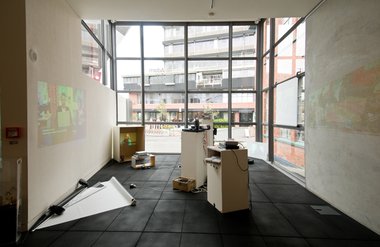
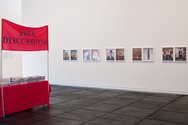

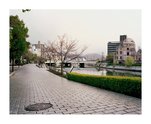
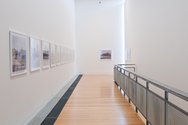
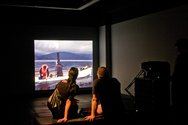
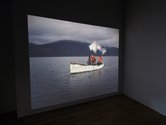


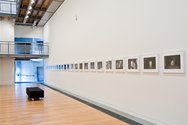
 Two Rooms presents a program of residencies and projects
Two Rooms presents a program of residencies and projects Advertising in this column
Advertising in this column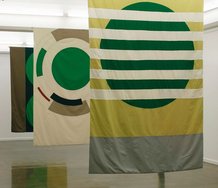
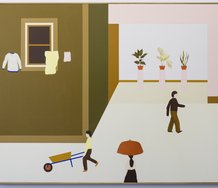
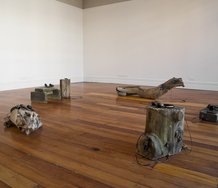
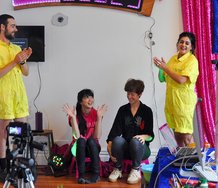
This Discussion has 0 comments.
Comment
Participate
Register to Participate.
Sign in
Sign in to an existing account.